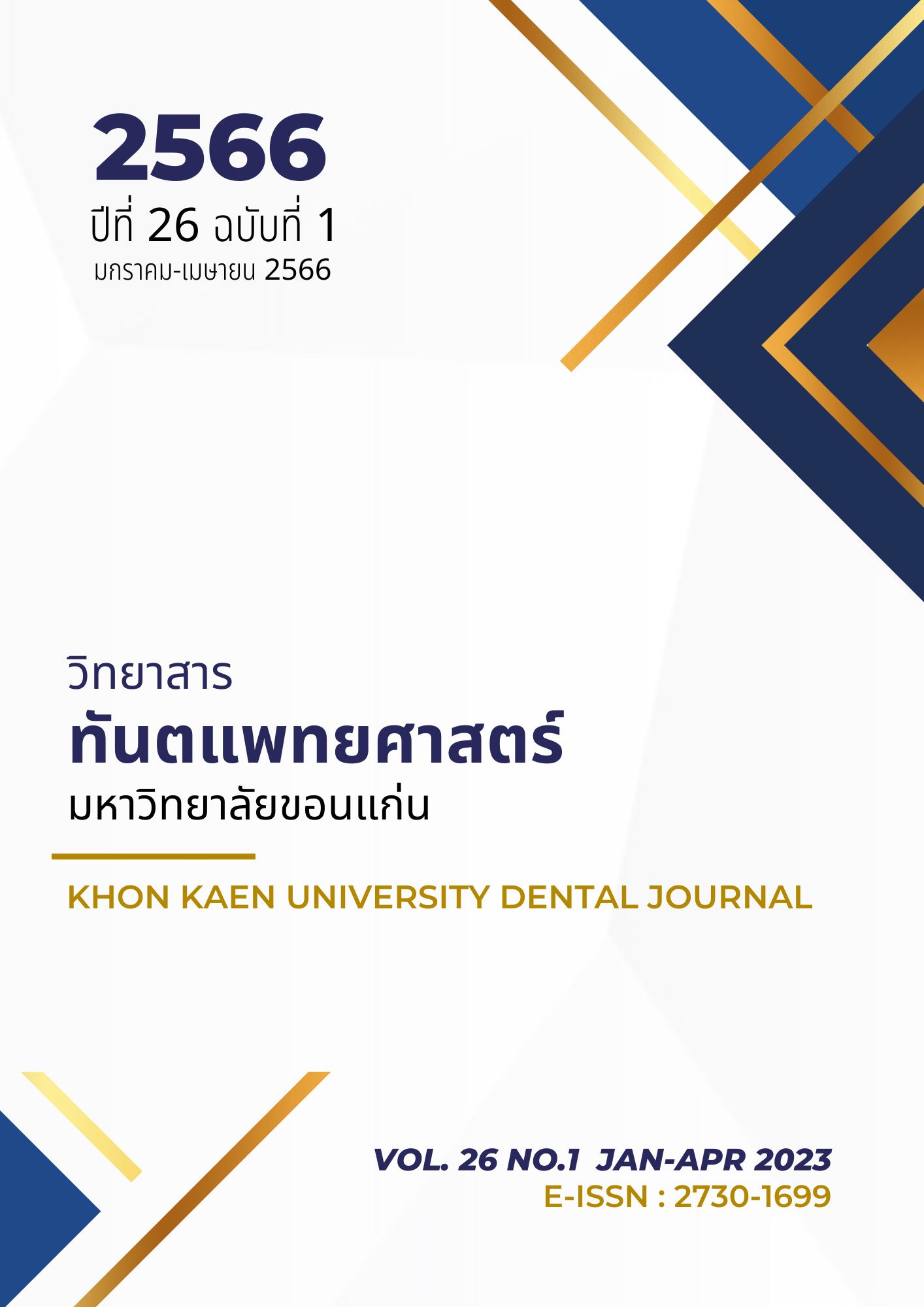ผลของโปรแกรมแชทบอทสร้างเสริมสุขภาพช่องปากต่อความรู้ในการดูแลสุขภาพช่องปากของผู้สูงอายุ
Main Article Content
บทคัดย่อ
การศึกษานี้มีวัตถุประสงค์เพื่อพัฒนาและประเมินโปรแกรมแชทบอทสร้างเสริมสุขภาพช่องปากสำหรับผู้สูงอายุต่อความรู้ในการดูแลสุขภาพช่องปาก ออกแบบเป็นกลุ่มวิจัยกึ่งทดลอง กลุ่มตัวอย่างคือ ผู้สูงอายุในโรงเรียนผู้สูงอายุบ้านสวน อ.เมือง จ.ชลบุรี จำนวน 57 คน ทำการศึกษาระหว่างเดือนธันวาคม 2564 - มีนาคม 2565 ใช้กระบวนการพัฒนาและปรับปรุงแชทบอทให้ความรู้ด้านสุขภาพช่องปากสำหรับผู้สูงอายุที่สร้างด้วยแพลตฟอร์มแชทฟลูเอลผ่านช่องทางเฟซบุ๊กแมสเซนเจอร์ ชื่อ แชทบอทวัยเก๋า สุขกาย สบายปาก มีการประเมินระดับความรู้ด้านการดูแลสุขภาพช่องปากผ่านการสัมภาษณ์เทียบก่อนและหลังการใช้แชทบอท 14 วัน และประเมินความพึงพอใจต่อการใช้งานแชทบอท วิเคราะห์ข้อมูลโดยใช้ค่าร้อยละ ค่าเฉลี่ย และแพร์ ซิมเปิล ที เทสต์ พบว่าผู้เข้าร่วมวิจัยส่วนใหญ่เป็นเพศหญิงร้อยละ 81 อายุเฉลี่ย 67 ปี ภายหลังได้รับโปรแกรมแชทบอทต่อเนื่อง 14 วัน มีผู้เล่นครบทุกวัน ร้อยละ 63.2 เวลาเล่นเฉลี่ย 11 วัน โดยผู้สูงอายุสามารถตอบคำถามด้านการดูแลสุขภาพช่องปากได้ถูกต้องเพิ่มขึ้นในทุกหัวข้อและมีคะแนนเฉลี่ยความรู้ด้านสุขภาพช่องปากก่อนและหลังได้รับโปรแกรมแตกต่างอย่างมีนัยสำคัญทางสถิติ (ก่อน 7.53±1.81 หลัง 9.72±1.60 คะแนน) (P<0.001) มีความพึงพอใจต่อแชทบอทระดับดีมากทุกหัวข้อ (คะแนนเฉลี่ย 4.63±0.27) หัวข้อพึงพอใจสูงที่สุดได้แก่ เนื้อหาภายในแชทบอท สามารถนำไปใช้ได้จริงในชีวิตประจำวัน ด้านอุปสรรคในการใช้งานพบว่าผู้สูงอายุมีปัญหาในการอ่านข้อความ การกดปุ่มตัวเลือก และความไม่ต่อเนื่องในการแจ้งเตือนของแชทบอท สรุปได้ว่า โปรแกรมแชทบอทสามารถส่งเสริมให้ผู้สูงอายุมีความรู้ในการดูแลสุขภาพช่องปากมากขึ้น โดยมีความพึงพอใจในการใช้งานอยู่ในระดับดีมาก จึงควรมีการพัฒนาแชทบอทเพื่อนำไปประยุกต์ใช้ในการดูแลสุขภาพช่องปากของผู้สูงอายุในชุมชนต่อไป
Article Details

อนุญาตภายใต้เงื่อนไข Creative Commons Attribution-NonCommercial-NoDerivatives 4.0 International License.
บทความ ข้อมูล เนื้อหา รูปภาพ ฯลฯ ทีได้รับการลงตีพิมพ์ในวิทยาสารทันตแพทยศาสตร์ มหาวิทยาลัยขอนแก่นถือเป็นลิขสิทธิ์เฉพาะของคณะทันตแพทยศาสตร์ มหาวิทยาลัยขอนแก่น หากบุคคลหรือหน่วยงานใดต้องการนำทั้งหมดหรือส่วนหนึ่งส่วนใดไปเผยแพร่ต่อหรือเพื่อกระทำการใด ๆ จะต้องได้รับอนุญาตเป็นลายลักษณ์อักษร จากคณะทันตแพทยศาสตร์ มหาวิทยาลัยขอนแก่นก่อนเท่านั้น
เอกสารอ้างอิง
Wongworasun S, Hunsrisakhun J, Watanapa A. Effectiveness of oral exercise program on oral function among independent elderly people: a cluster randomized controlled trial [dissertation]. Songkhla: Prince of Songkla University;2021.
Bureau of Dental Health. The 8th Thailand national oral health survey report. Bangkok: Sam Chareon Panich;2017.39-41.
Suraseranivong R. Oral cavity in elderly. JCP 2018;14(1):87-100.
Minakuchi S, Tsuga K, Ikebe K, Ueda T, Tamura F, Nagao K, et al. Oral hypofunction in the older population: Position paper of the Japanese Society of Gerodontology in 2016. Gerodontology 2018:35(4)317-24
Positioning Magazine [Internet]. Insight into the way of the media age “LINE-TV-FACEBOOK” Occupying the old age [updated 2018 Sep 5]. Bangkok Religion Information. Available from: https://positioningmag.com/1186242. (In Thai)
Wu T, Deng Z, Feng Z, Gaskin DJ, Zhang D, Wang R. The effect of doctor-consumer interaction on social media on consumers' health behaviors:Cross-sectional study. J Med Internet Res 2018;20(2):1-14.
Bibault JE, Chaix B, Guillemassé A, Cousin S, Escande A, Perrin M, et al. A Chatbot versus physicians to provide information for patients with breast cancer: blind, randomized controlled noninferiority trial. J Med Internet Res 2019; 21(11):1-7.
Chaix B, Bibault JE, Pienkowski A, Delamon G, Guillemassé A, Nectoux P, et al. When chatbots meet patients: one-year prospective study of conversations between patients with breast cancer and a chatbot. JMIR Cancer 2019;5(1):1-7.
Jang S, Kim JJ, Kim SJ, Hong J, Kim S, Kim E. Mobile app-based chatbot to deliver cognitive behavioral therapy and psychoeducation for adults with attention deficit: a development and feasibility/ usability study. Int J Med Inform 2021; 150: 104440.
Hunsrisakhun J, Pithpornchaiyakul S, Heemsuree N, Phiancharoen W, Sornsung C, Subkamondit R, et al. Effectiveness of promoting on tooth brushing behavior for children 6 mouths-2 years old by caregivers under application of Protection-motivation theory and social media based on adaptation learning 21 for FUN. Report. Songkhla: Department of Preventive Dentistry, Faculty of Dentistry, Prince of Songkla University; 2020.
Best JW. Research in education. 3rd ed. New Jersey: Prentice Hall; 1997.
Pengsawat W. Research and development. SNRU J 2009;1(2):1-12.
Zhang J, Oh YJ, Lange P, Yu Z, Fukuoka Y. Artificial intelligence chatbot behavior change model for designing artificial intelligence chatbots to promote physical activity and a healthy diet: viewpoint. J Med Internet Res 2020;22(9):1-13.
Fitzpatrick KK, Darcy A, Vierhile M. Delivering cognitive behavior therapy to young adults with symptoms of depression and anxiety using a fully automated conversational agent (woebot): a randomized controlled trial. JMIR Ment Health 2017;4(2):1-11.
Fufaung T, Chaleonnan A, Chokchuepattanakit W, Thongngam P, Schmitt R. Development of digital literacy learning chatbot for undergraduate students. In:Prakancharoen S, Samutrak P, Sutthaluang N, Mookdarsanit P, editors. Proceedings of the 4th National Conference in Science and Technology; 2021 May 22; Faculty of Science, Chandrakasem Rajabhat University. Bangkok, Thailand; 2021. 29-38.
Sap-in R, Khaoroptham Y. The elderly and Media in Thailand. DPU Comm Arts Journal 2017;11(2):367-87.
Wiratunga N, Cooper K, Wijekoon A, Palihawadana C, Mendham V, Reiter E, et al. FitChat: conversational artificial intelligence interventions for encouraging physical activity in older adults. arXiv:2004.14067v1. 2020 Apr [cited 2022 Mar 10]. Available from:https:// arxiv.org/pdf/2004.14067.pdf
Maltz M. 21-Day Habit Theory. Psycho cybernetics and self-fulfillment. Deluxe edition. Englewood Cliffs, New Jersey: Prentice-Hall, Inc.; 2016.
Lally P, Van Jaarsveld CHM, Potts HWW, Wardle J. How are habits formed: Modelling habit formation in the real world. Eur J Soc Psychol 2010;40(6): 998-1009.


